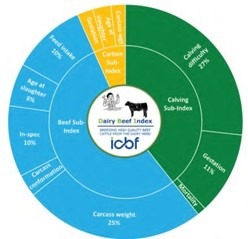Maximising the beef potential of the dairy herd – Alan Twomey, Teagasc & Ross Evans, ICBF at the Teagasc National Dairy Conference 2022 ‘Turning Challenges into Opportunities
Introduction
The usage of beef bulls on dairy cows will continue to grow due to the improvements in cow fertility and the increased usage of sexed semen. The number of replacements required is reducing due to cows surviving longer as well as less animals needed for expansion in many dairy herds. In addition, there is increased concerns over calf exports and whether or not these will continue for the foreseeable future. Fifty-seven percent of the national slaughter kill originate from the dairy herd at present, a number which is expected to increase. However, there is a very poor retention of beef farmers in dairy beef systems with only 42% of beef famers continuing to buy calves in each subsequent year. To ensure that there will be beef farmers to rear the increased number of dairy beef calves in the future, dairy farmers need to provide calves to beef farmers that are healthy and of good beef merit, at a price that the beef farmer can make a profit.
Increasing beef bull usage on the dairy herd
Firstly, at the start of the breeding season dairy farmers need to identify the number of replacement heifers they require and use dairy semen accordingly to reach this target. Using sexed semen is the easiest way of increasing beef usage on the dairy herd, but only dairy farmers with high fertile animals should use sex semen to ensure it does not negatively impact herd fertility performance. Although, beef bulls are typically used at the end of the breeding season, dairy farmers should aim to look at using beef bulls earlier in the breeding season on low genetic merit cows (i.e. poorly ranked on the EBI), poorly performing cows and problem cows. Additionally, there is an opportunity to use beef bulls on cows cycling prior to the target breeding season start date. If beef bulls with longer gestation were used up to a week before dairy inseminations, there would be an increased number cows calving earlier in the calving season, with no negative impacts on compactness.

Selecting beef sires
Dairy farmers place a large focus on the selection of dairy sires each year. On the contrary, selecting beef sires is often done by picking most easily calved and short gestation sire available. Nevertheless, the selection of the beef bull determines the economic performance of the progeny for the beef farmer and as a consequence the likelihood of them purchasing calves again. The dairy farmer has the power of making their dairy beef calves more of an attractive option by using higher beef merit bulls. The Dairy Beef Index (DBI), available since 2019, enables dairy farmers to pick beef bulls which are easy calving and short gestation, but also higher beef value.
New era for beef breeding
Until now, beef breeding focused on carcass weight, conformation and fat score. Thus, the goal was to breed heavier muscled animals, which receive a high value carcass at slaughter. However, the cost of each extra day it took to slaughter an animal was not considered. Due to new research in Teagasc, the DBI will now include an age at slaughter trait which will identify sires that will have progeny ready for slaughter at a younger age. Age at slaughter will be included in the updated DBI at cost of €1.35/day, which represents the average cost of keeping animal across the year, at a relative emphasis of 6% (Figure 2). Carbon emissions from the dairy and beef herd is becoming a major concern in future years. Although carbon is not a direct economic cost for farmers today, it is possible that farmers will be charged for carbon in the future so the inclusion of a carbon component in the DBI will breed an animal with a lower carbon footprint. It will be the first beef breeding objective in the world to include an age at slaughter trait and a carbon sub-index.

Commercial Beef Value to drive quality calf demand
The Commercial Beef Value (CBV) is a genetic tool for animals destined for slaughter to predict their beef merit for buyers. It is the first time dairy-beef farmers can control the genetic merit of calves they purchase. Animals with a higher CBV, on average will be heavier, more conformed and younger at slaughter. The introduction of the CBV is both a positive for the beef, more informed at purchasing and dairy farmers, which will get rewarded for higher beef merit animals. This will be available in marts also for animals with a genotype to guarantee correct parentage.
Conclusion
Dairy farmers will need to place higher relevance on beef breeding to ensure they have a saleable calf that is suitable for a beef farmer. Key steps dairy farmers need to take for the next breeding season are to, 1) minimise the number of dairy males, 2) identify poor cows that should be inseminated to beef, 3) use more beef AI, 4) select beef bulls with a high DBI index, 5) use sire advice for beef mating’s to minimise calving difficulty and maximise beef potential. Improving beef from the dairy herd will ensure a sustainable integration of both the beef and dairy industry.
Summary
- Sexed semen and improved survival of dairy cows allows for increased usage of beef in the dairy herd
- Using the Dairy Beef Index to select beef sires, will improve the beef merit of your calves with no increase in calving difficulty
- Commercial Beef Value (CBV) will improve the demand for high beef merit
For more information on the DBI or CBV, please contact ICBF on 023-8820452 or email [email protected]. You can also listen to the podcast below which gives some more detail on the DBI.
